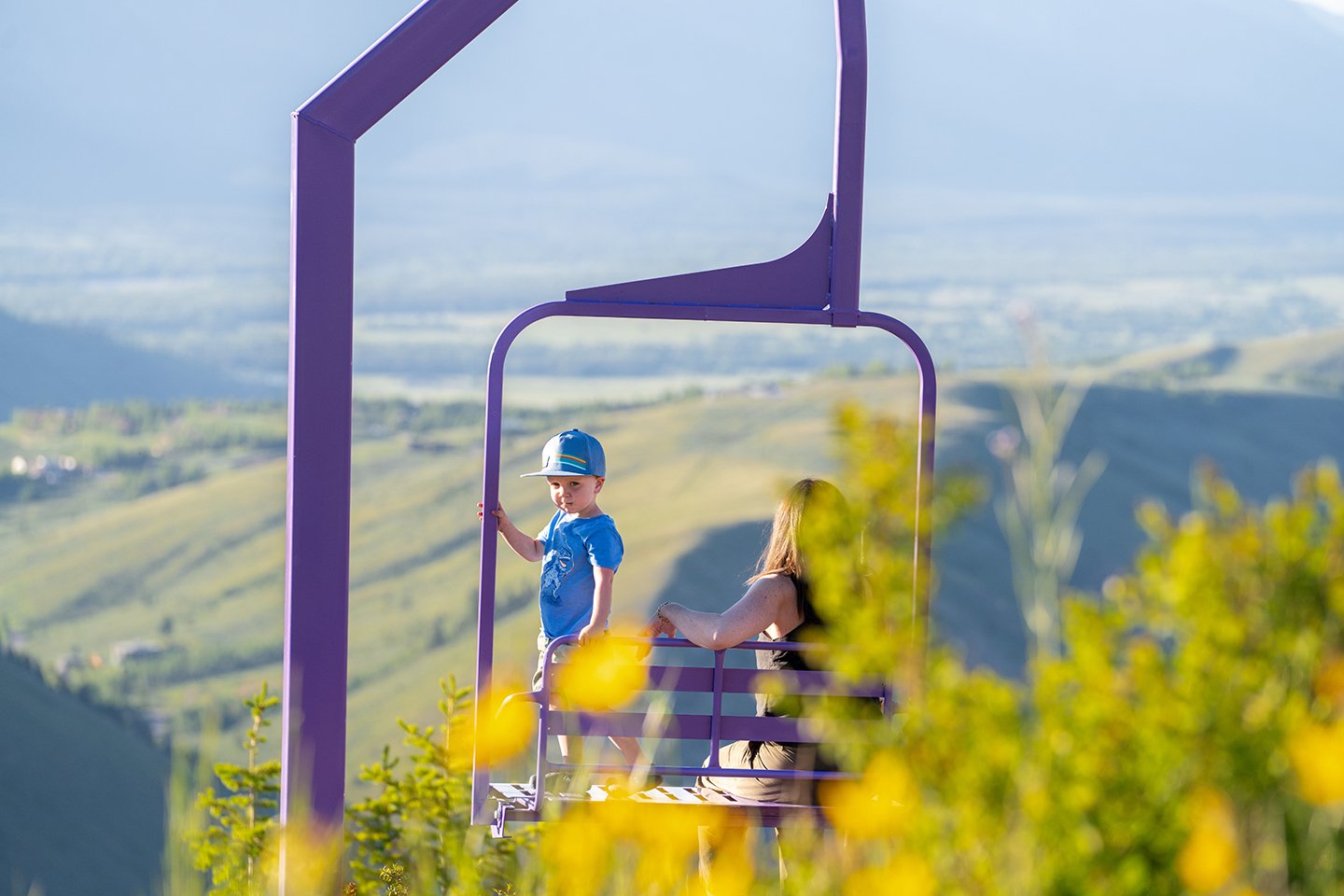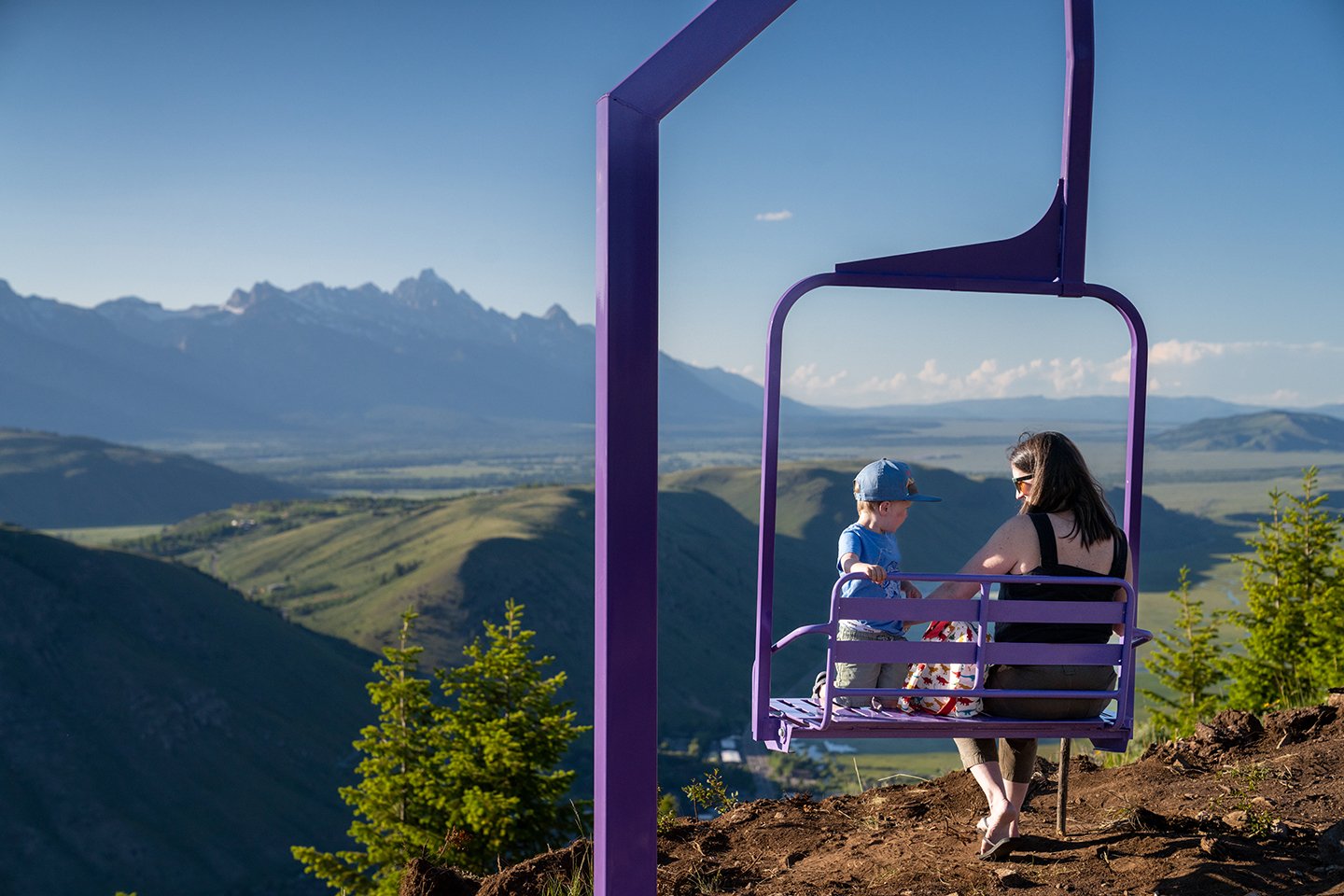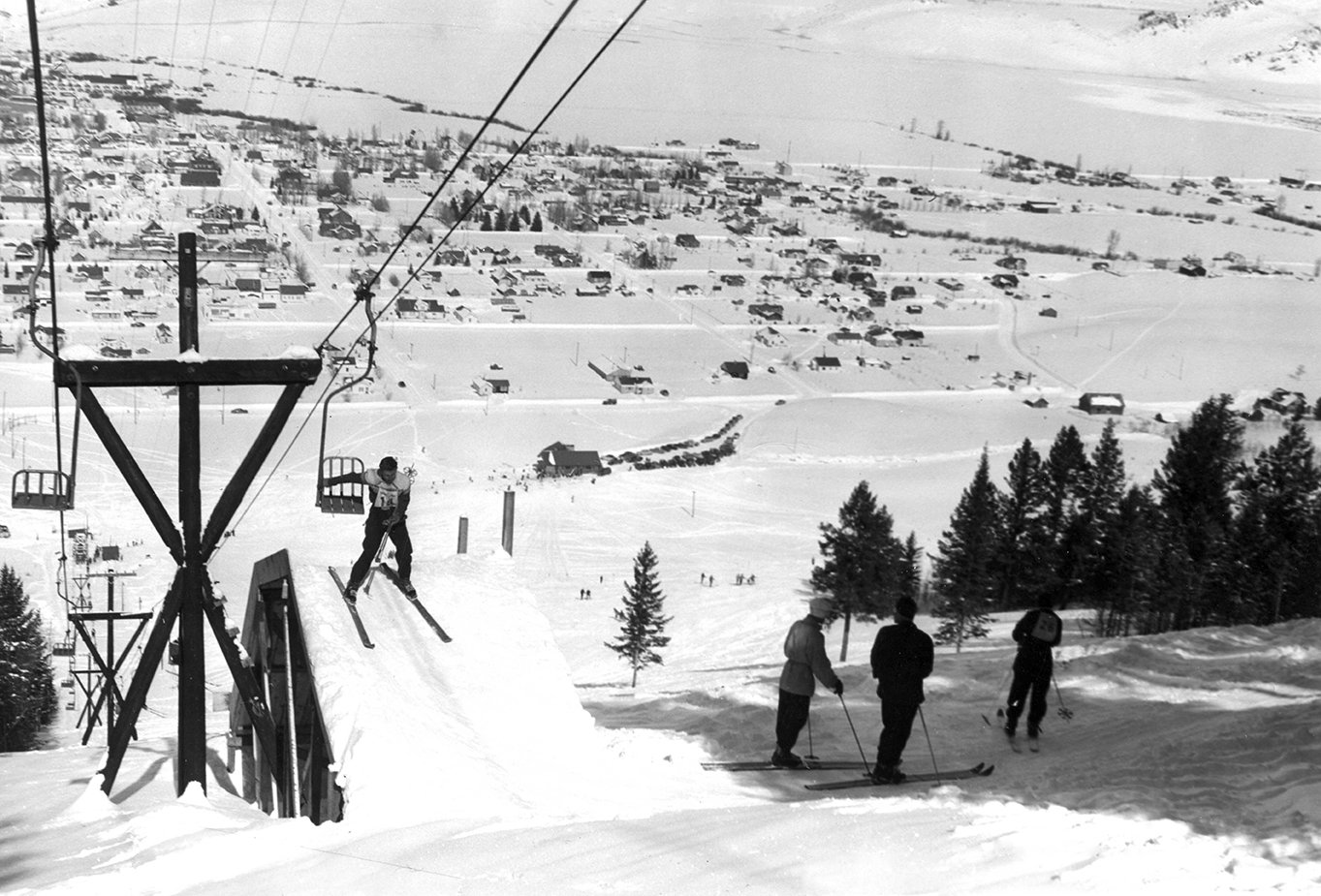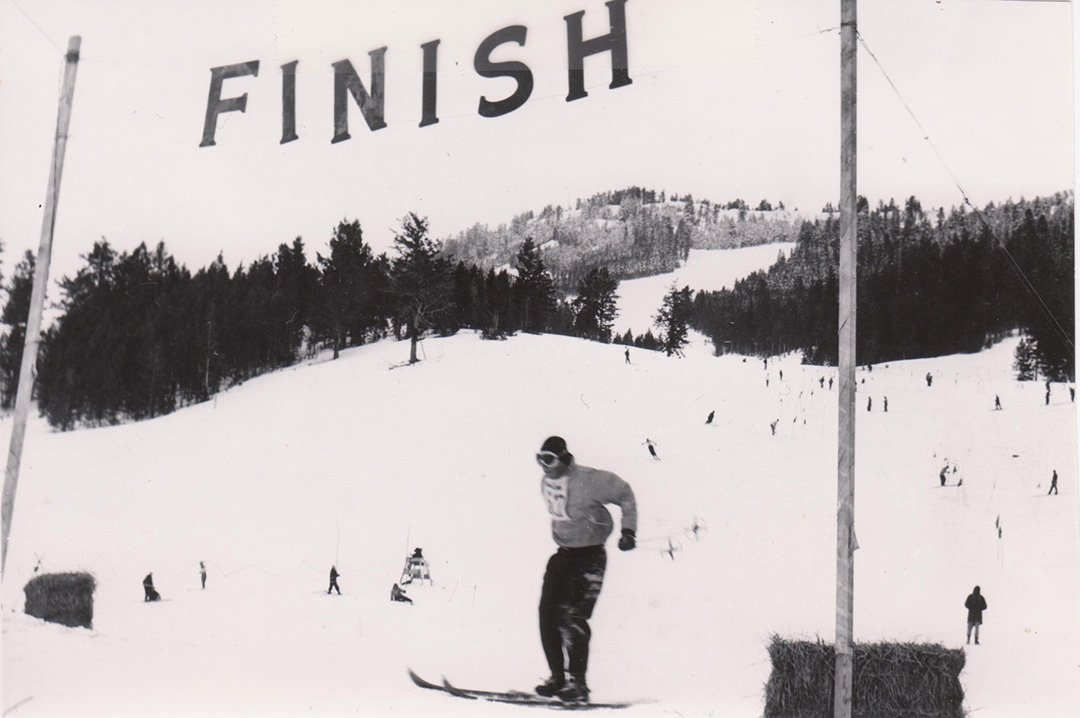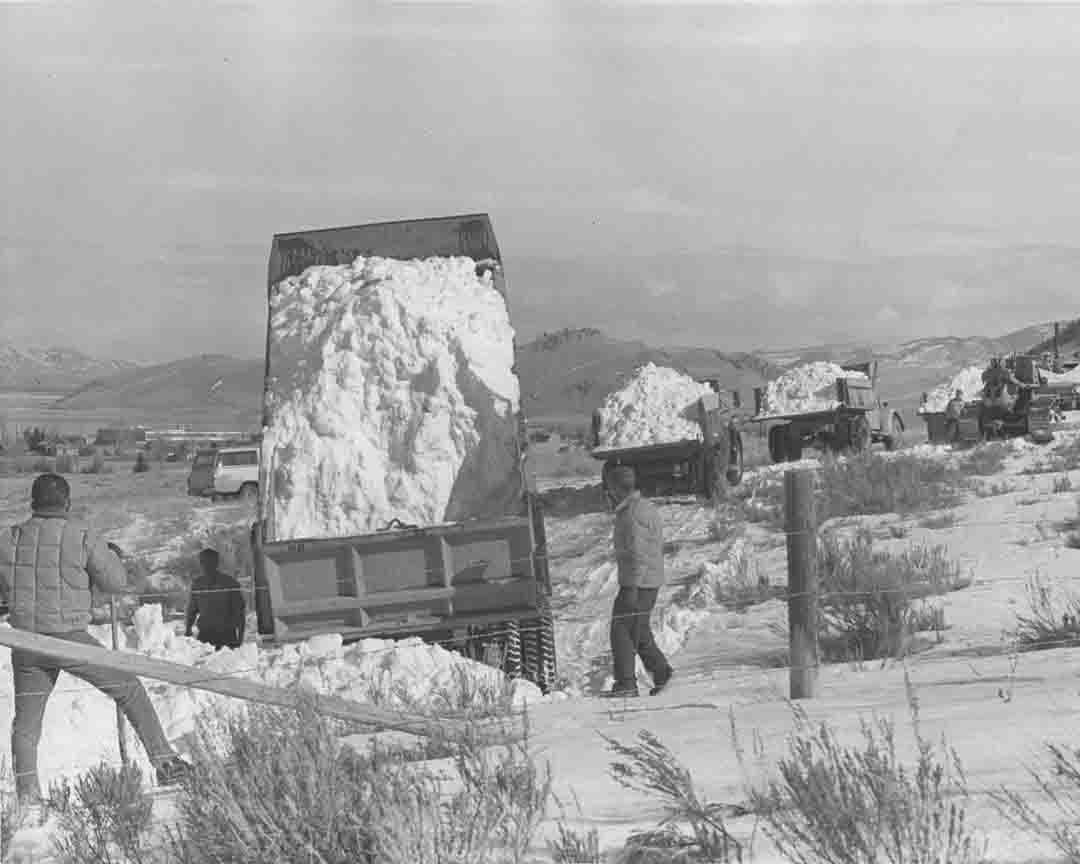Snow King: Square to Summit
Project Launch Date: August, 2021
Installation Date: Spring, 2023
Location: Cache Street, Jackson WY
Partners: JH Public Art, Jackson Hole Chamber of Commerce, and Snow King Mountain
“Businesses were lining up to be part of sharing Snow King’s heritage. Having the opportunity to partner on this installation has been a positive and rewarding experience that brings together private and public resources in the best possible outcome, for everyone to enjoy.”
Over 30 local businesses and organizations have provided support for the Square to Summit project, a public art partnership between Snow King Resort, JH Chamber of Commerce, Town of Jackson, and JH Public Art. Twenty-five salvaged Snow King Summit lift chairs have been repurposed as colorful benches and swings to form a walking corridor from downtown Jackson to the Snow King summit. This project celebrates Jackson’s unique cultural identity, history, and people by elevating local ski culture, its heritage, and our landscape. The installations provide a place to be outdoors, relax, connect, and discover the history of Snow King Mountain.
A public art project of this scale brings together many local and regional entities, requiring collaboration between the public and private spheres and the support of many generous sponsors. Jorgensen Engineering and Nelson Engineering handled aspects of the complicated technical work behind this installation; Westwood Curtis Construction completed all excavation work; Premier Powder Coating out of Rexburg, Idaho undertook all steel and custom color powder coating; and Two Ocean Builders provided logistical support, some of which also function as swings.
This project is based in historic preservation, encouraging vibrant walkable areas and acknowledging the important role Snow King Mountain plays in our lives both in terms of as an economic driver and as a place for our community to recreate together. Signage at each installation celebrates this history, with interpretive support from the JH Historical Museum & Society, as well as recognizes businesses that have contributed funds to the project.
Businesses and individuals interested in sponsoring a chair can download a Sponsor Pledge Form Here and contact Carrie Geraci.
COMMUNITY SPONSORS:
Anvil Hotel
Berkshire Hathaway
Center for the Arts
CN Engineers
Deb and Peter Keenan & Family
Erika Pearsall & Ned Jannotta
Gallery Wild
Guild Mortgage
Haagen Dazs
Hotel Jackson
In loving memory of Karen Oatey
JD High Country Outfitters
JH Jewelry Co.
JH Wildlife Safaris
Jorgensen Engineering
The Kudar
Lee's Tees
Made JH
Million Dollar Cowboy Bar
Nelson Engineering
Northworks Architects
Pinky G's Pizzeria
Snow King Resort Hotel
Stio
The Lexington at JH
The Liquor Store
Town Square Inns
Two Ocean Builders
Two Ocean Trust
Wort Hotel
Wyoming Cultural Trust Fund
Wyoming Humanities
TITLE SPONSORS:
Bank of Jackson Hole
Community Foundation of Jackson Hole
JH Chamber of Commerce
JH Historical Society & Museum
JH Public Art
Newton Foundation
Premier Powder Coating & Custom Fabrication
Snow King Mountain
Snow King Resort Master Association (SKRMA)
Town of Jackson
Westwood Curtis Construction
Historic Snow King Stories
Photos courtesy of Jackson Hole Historical Museum & Society
Gathering Places
Talk to any old-time Jackson skier about Snow King, and you’re sure to hear about the old Ski Shelter, which was constructed of logs over a period of years starting in 1939 and was dedicated by local conservationist Olaus Murie in 1944. “We got a set of house logs and put it up, just a bunch of volunteers hammering away,” said Virginia Huidekoper. For almost 50 years the Ski Club’s Shelter at the base of Snow King was home to potlucks and racers coming out of the cold between runs.
The Ski Shelter was demolished in 1992 to make way for the Snow King Center. The Center consists of a base lodge and cafeteria for skiers, headquarters for the Jackson Hole Chapter of the National Ski Patrol and a full-sized indoor ice rink that is used by the community at large. The Center also functions as a convention center.
“Few cared when the fireplace smoked or that the carpet was a ghastly color.”
– Connie Wieneke
Another popular gathering place was the steel and glass Panorama House, built in 1960 at the summit of the mountain next to the Summit Lift. Perched on the edge of the hilltop with windows and a deck on three sides, Panorama House provided snacks and incomparable views and was a favorite lunch spot at the top of Snow King. It also functioned as the de facto center of the popular Conquer the King hiking contest. Also at the top of the mountain were the former engine house for the old Snow King Lift which served for years as the Ski Patrol Cabin, and the little wooden Snack Shack, where skiers ordered snacks and drinks from a service window. In the summer the building was used as a photo center, where visitors purchased photos of themselves reaching the top of the lift.
“Demolition of the old Shelter signaled the end of an era. No longer could dances and box socials alone pay for buildings and coaches.”
– Connie Wieneke
Ski Jumps and Ski Circuses
Snow King has a history of ski entertainment, starting with jumping. The earliest skiers hiked up the mountain and skied down at top speed over homemade jumps, trying their best to get airborne on their 7-foot boards weighing nearly 15 pounds each. When the first wooden ramp was erected in the late 1930s, crowds began to gather to watch the local daredevil ski jumpers sail through the air.
The Jackson Hole Ski Association promoted skiing in Jackson and nationwide by hiring ski circus entertainers such as the “Hoback Boys,” who dressed in Western clothes and big cowboy hats and performed tricks on skis including jumping through fiery hoops. Themed and costumed ski races, the “Town Downhill,” jumping contests, ski-joring and sled-dog races and Ski Balls raised money for new lifts and encouraged locals to get on their skis. The ski school’s Winter Carnival for kids has been a staple of Jackson Hole life since 1967. Snow King is the only place in Jackson that offers night skiing for those who are too busy working during the day, or just like the thrill of skiing in semi-darkness.
Snow King’s anniversaries are occasions for community-wide celebrations. The 50-year anniversary in 1989 was a “wild, week-long bash” that went on for nine days and featured all kinds of ski races, outdoor barbeques, concerts, fireworks, a mountain torchlight parade, and a Boring Slide Contest, as well as dances and banquets honoring Snow King’s founders.
“Everybody around here in the early thirties was just going to the top of the hill and going straight down and trusting to a bit of ability and a heck of a lot of luck.” – Neil Rafferty
Nine-foot Skis and a Sapling for a Pole
Skiing was a necessary form of transportation in early Jackson, along with dog or horse sleds and snowshoes. Mail carriers and other skiers whittled 8- to 9-foot-long skis from split lodgepole pine, bowed the tips by steaming them, and nailed leather straps to the sides for bindings. They used elk tallow and pine pitch for wax, and fashioned climbing skins from elk hair.
When downhill skiing as a sport started, the equipment was not much better. Most skis were handmade, with various methods of attaching boots, from leather toe pieces and bands of inner tube around the heel, to permanently encasing boots in iron bindings, with straps across the top and around the heel. Bases were sometimes waxed with melted phonograph records. Poles were cut on the spot from saplings - just a single long pole was used to check speed or sometimes help with a turn. Ski clothes were whatever kept you warm – wool pants or knickers with canvas gaiters, topped with anything from a Navy pea coat to a mink jacket or below-the-knee overcoat.
The Dartmouth ski team, who came to Jackson in 1938 to train, showed the modern method of skiing using two poles and fixed-heel bindings. With the popularity of lift-served skiing, equipment developed with tip-to-tail metal edges, laced leather boots with ankle support, and around-the-heel cable bindings. The commercialization of skiing brought specialized equipment for all kinds of skiing – recreational, racing, back country, as well as cross-country and track skiing.
“On the chairlift for the first time, I caught my tips on the first Station and had to jump. Heading straight for the bottom I hit a bare patch and lost a ski along with my boot. I got demoted back to the Bunny Tow.” – Zaidee Fuller
The Locals Pitch In
Snow King was always a community project. From the first rope tow through the building of the ski shelter to hosting races and serving as gatekeepers and timers, locals pitched in. “Many people really helped at these critical times,” said Neil Rafferty, “by cutting trees, burning and building the ski shelter. Many businessmen in town would finance a man’s wages for one day or two days. The community really appreciated what skiing could do for them.” Community members manned the ski patrol which was established as the Jackson Hole Chapter of the National Ski Patrol in 1941. They cleared trails and even performed secretive night-time tree cutting to open up problem areas where the Forest Service declined to allow additional cuts.
The night before a 1939 ski meet, elk pushed away the snow that had been covering the log landing area for the ski jump and ate the hay underneath. Before the competition could start, volunteers laid down new hay and transported snow in bushel baskets to cover it. In 1954, concerned about the lack of snow on the slopes prior to the Junior Nationals, residents began hauling snow by truck from the national forest in Wilson – until they were stopped by the Forest Service. Undeterred, local ski enthusiast Jim Huidekoper drove all the way to Colorado Springs to procure a snow-making machine, which was used round the clock but only produced ¼ inch of snow. Fortunately nature cooperated and brought a good snowfall just before the meet.
“Because of the diverse background of the membership on the patrol, I was able to meet a variety of residents from our community. The bonding and comradery of this patrol instantly made me feel like I was a part of an extended family. 38 years later, that feeling persists. “ – Kevin Johnson
Snow King: Babysitter of Choice
Kids in Jackson grew up skiing, even before they had skis. “We had just a leather strap and you’d use a piece of inner tube around your heel,” said Margaret Schultz who went on to be an Olympic contender in 1951. Before ski shops and ski schools, the rare pair of skis was shared among a group of kids. “We’d just point ‘em down til we’d fall down.” Neil Rafferty and Snow King became the town’s preferred babysitter. “Their mothers would drop them off,” said Rafferty. He encouraged skiers of all ages and abilities and gave kids odd jobs to do when they didn’t have the money for a pass.
“My kids were brought up on that mountain. Everybody’s kids were. You could leave the babies in the bassinet in the station wagon at the bottom of the hill, take a run, then go check on them.” – Virginia Huidekoper
Older kids hitched a ride from town to the slopes. They stood on the road on their skis, waiting for cars to stop so they could grab the rear bumper and “hookybob” to the base of Snow King.
Chuck Helms opened the first ski school at Snow King in 1940 and with a little training the Snow King kids went on to ski in high school and college teams and compete and coach nationally and internationally. Bill Briggs took over the ski school at Snow King in 1964, eventually making it into the Great American Ski School.
“We made trails in the woods that were fun to ski. At the end of the day, we would hide in the woods on our “secret” trails until the Ski Patrol finished their sweep. Then we would finish the last run of the day and end up in our backyards. We were the Kings of the hill! – Jeff Crabtree and Peter Ashley
The Father of Snow King
Neil Rafferty arrived in Jackson from Detroit in 1930 and was one of the daring early skiers on the Town Hill. After years of hiking up to Old Man’s Flats and skiing down the hill, Rafferty won a contract with the Jackson Hole Ski Club to build an “uphill facility.” He cut a narrow swath through the heavy forest and fashioned an unusual tow rope. Skiers used metal clamps to attach themselves to a cable salvaged from an oil drilling rig. Powered by an old Ford tractor, the tow could take 18 skiers at a time on the 8-minute ride to Old Man’s Flats. Skiers were supposed to return the clamps to the base after their ride, but many left them at the top for Rafferty to collect on his sled at the end of the day.
With an easier way up the mountain, skiing’s popularity soared. Rafferty installed lights for night skiing. The Jackson Hole Ski Club sponsored races and other events for local and out-of-town skiers. Rafferty ran Snow King as sole operator and later manager for the Jackson Hole Winter Sports Association from 1939 until his retirement in 1974. His long dedication to skiing in Jackson Hole earned him the title “Father of Snow King.”
“For three generations, Snow King Mountain has been the town ski hill, and it and the first operator, Neil Rafferty, were valley parents’ babysitters of choice.” – Connie Wieneke
Ski Wyoming
All but two ski areas in Wyoming are located on U.S. Forest Service land. Snow King was the second ski area in the state to be permitted by the USFS (after Sleeping Giant near Cody). Although the earliest ski area in the country is Howelson Hill (1915) in Colorado, Sun Valley, which opened in 1936, is considered the country’s first destination ski resort. Alta and Snow King, both of which opened in 1939, were not far behind.
In the 1920s, downhill skiing on national forest lands grew in popularity as large numbers of Scandinavian immigrants shared their love of winter sports. To accommodate the higher demand, the Forest Service used the Civilian Conservation Corps in the 1930s to help build winter sports areas, including ski trails, sled runs, small ski lodges and warming shelters. Although intended as a horse trail, the CCC trail built in 1936 on Snow King was the area’s first ski run. The CCC also built trails at other Forest Service permitted ski areas in Wyoming. Nationwide there are 122 ski areas in the national forests that provide about 60 percent of the total capacity for downhill skiing in the United States.
The Town Hill
Snow King Mountain has shaped the image and character of Jackson Hole for over 100 years. The valley’s very first recreational skiers hiked up the mountain and skied down through the trees on 9-foot-long wooden boards strapped to moose-hide moccasins. Daredevils built makeshift ski jumps and soared over the snow. By the early 1930s, what had been known simply as the Town Hill was named the “Ruth Hanna Simms Ski Hill” in honor of the woman who funded the first official ski jump. The mountain’s first ski run was a switch-backing horse and hiking trail built to the summit of the mountain by the Civilian Conservation Corps in 1936. Skiing became an official local sport complete with ski jump competitions and downhill races with the formation of the Jackson Hole Ski Association and the Jackson Hole Ski Club, which changed the name of the mountain to Snow King in 1939.
“There were only about six people who could ski Snow King without falling all over themselves.” – Neil Rafferty
Little Waxers to Olympians
The Jackson Hole Ski Club formed in 1937, before there was a tow or lift at Snow King. The Club immediately sponsored a meet consisting of a jump and a downhill run. The downhill race started on Old Man’s Flat and followed the CCC horse trail to the foot of the mountain. Most skiers had not yet learned to turn, so they either stopped at each switchback to redirect their skis or crashed into the bushes.
When the first rope tow opened on Snow King in 1939, the Ski Club sponsored the First Annual Tri-State (WY, ID, UT) meet and invited racers from Alta, UT, to compete. Some of the competitors liked Snow King so much, they eventually moved to Jackson! Community support – from selling hot dogs and hamburgers to grooming the trails -- made Snow King a popular area for races and meets.
Ski racing at Snow King began at an early age with toddlers competing in the Little Waxers races and continued through high school and beyond. Besides producing some top competitors, Snow King has attracted international race teams who appreciate its steep runs, ample snow, custom grooming and friendly and supportive community. In 2002 Snow King’s proximity to the Winter Olympics in Utah lured eight international ski teams to train on the Town Hill for slalom and giant slalom races. Nine of the 60 competitors who trained at Snow King won Olympic medals!
“Snow King had the best ski races held in the United States for years and years. They had more devoted people in Jackson that were out there for gate keepers, timers and starters.”– Mugs Schultz, 1973
Ore Buckets to Ski Chairs
When skiing began to take off after World War II, the original Snow King tow couldn’t keep up with the demand. The answer? A chairlift bought from an old gold mining operation in Colorado. The ski area installed the towers and bullwheels, strung the cable, replaced ore buckets with single chairs and the 3,800’-long lift was ready to go, magically lifting people 1400’ up to the top of Snow King. The new lift, along with two rope tows, two jumps, and two warming lodges, made Snow King a real ski destination – although one with many trees, narrow, twisting slopes and the occasional slipping chair. Helpfully, a 1948 brochure about Jackson Hole noted that “the ski lift is located within six blocks of one of Wyoming’s best equipped hospitals.”
In 1959 the then outdated single chairlift was replaced by a double chairlift with a modern unloading platform (now an observation deck). But the lift wasn’t just for skiers. In the summer you could ride the lift to the summit to get a snack and take in the view at the glass-walled restaurant known as Panorama House. The old lift was eventually replaced with the Summit double chairlift in 1978 when the Rafferty Lift was also built on the east side, accessing a new alpine slide. Helicopters helped in the construction of the triple-chair Cougar lift in 1994 which opened up intermediate terrain.
“I was the first guy to ever ride the chairlift. I was so flabbergasted that I couldn’t think of anything to say when I got off.” – Neil Rafferty

